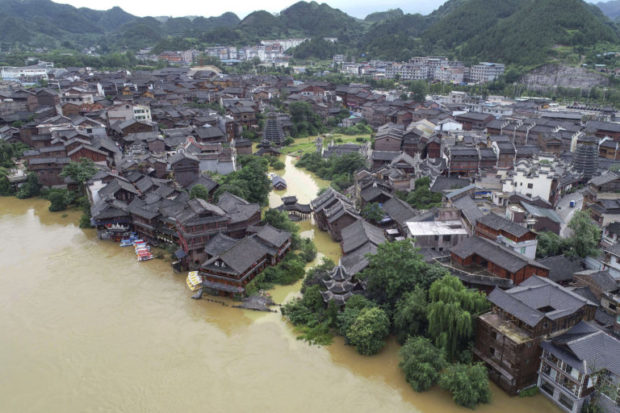The central Chinese city of Wuhan, epicenter of the new coronavirus pandemic, raised its flood alert level on Monday as torrential rain and thunderstorms battered swathes of the country, including the Yangtze river on which it sits.
Wuhan upgraded its emergency flood response to Level II from Level III, the second highest on its four-tier scale, after days of heavy downpours submerged many of its roads.
Authorities warned in March that Wuhan and other flood-prone cities on the Yangtze’s middle reaches faced higher than usual levels of rainfall this year.
Mayor Zhou Xianwang promised that crucial flood defense work would not be affected by the coronavirus outbreak, which saw the city locked down for more than two months. The city was badly hit by devastating floods on the Yangtze in 1998.
Torrential rains continued to batter China on Monday from Chongqing in the southwest to Shanghai on the east coast. The provinces of Zhejiang, Anhui and Jiangsu all declared “yellow alerts.”
Water exceeded warning levels at more than 50 locations along China’s rivers, according to data from the Ministry of Water Resources on Monday.
Chen Tao, a senior forecaster with the China Meteorological Administration (CMA), said regions along the Yangtze could see as much as 400 mm [15.75 inches] of rainfall in the next three days.
Particular attention needed to be paid to small and medium-sized rivers and to risks such as mudslides and the inundation of farmland, he said.
“Heavy rainfall may be the first step in a chain of disasters,” he was quoted as saying on the bureau’s website.
CMA officials told a briefing on Friday that rainfall in June was 13.5% higher than the seasonal norm. Occurrences of torrential rain and thunderstorms were 43% higher than the 2017-2019 average, they added.
(Reporting by David Stanway; editing by Hugh Lawson)
Photograph: An aerial view shows the ancient town of Xiasi during flooding in Kaili city in southwest China’s Guizhou province on Tuesday, June 23, 2020. Photo credit: Chinatopix via AP.





















 Surge of Supercharged Hurricanes Prompt Call for Cat 6 Classification
Surge of Supercharged Hurricanes Prompt Call for Cat 6 Classification  What to Expect in 2026: U.S. P/C Results More Like 2024
What to Expect in 2026: U.S. P/C Results More Like 2024  Why the Middle Market Matters and How Insurers Can Capture It
Why the Middle Market Matters and How Insurers Can Capture It  Berkshire Hathaway Enters Post-Buffett Era as Share Prices Fall
Berkshire Hathaway Enters Post-Buffett Era as Share Prices Fall 









